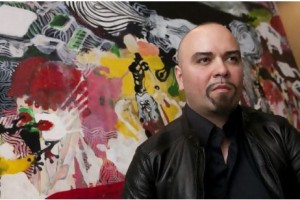By Colin Simpson www.thenational.ae
DUBAI // The opening of an exhibition of paintings and sculptures by the Romanian artist Bogdan Lascar is the latest example of a trend in which increasing numbers of European artists are choosing the UAE to showcase their work.

The show, Neurophysiological Neo-Opera of Shapings, will continue at the west wing atrium at the Dubai International Financial Centre (DIFC) until April 26.
In the past few weeks the French artist Jean Charles Yaich has shown his white-paper sculptures at the Alliance Française in Dubai, and an exhibition of work by British new-wave artists has been staged at the city’s Etemad gallery. In Sharjah, meanwhile, 120 artists – all but two from outside the UAE – are displaying work at the mammoth Biennial event.
“There are definitely more and more European artists coming over,” said Antonia Carver, director of last month’s Art Dubai event.
“The development of Dubai as a cultural capital began with it being, in terms of the commercial art world, the centre for Middle Eastern art.
“But what we’re seeing now is what people call cross-buying. Collectors and supporters who started off very much interested in art from their own country or region are beginning to collect much more widely now, and take an interest in a much wider field of work.
“So you’re seeing more and more European artists coming here as well, and galleries have the confidence to show artists from different parts of the world. In a way the globalisation of the art world is particularly stark in Dubai.”
She said recent exhibitions of work by foreign artists proved very popular.
“This latest trend of European artists coming to show here reflects the gradual widening of the arts scene.
“It’s also important to look at places like the Mojo gallery, which does exhibitions with contemporary African artists, and those exhibitions have been very popular too.
“This perhaps reflects the history between the East coast of Africa and the Gulf, the exchange of trade and ideas and culture.”
The director of the Alliance Française, Dominique Chevallier-Wixler, suggested that the trend towards foreign artists exhibiting in Dubai had been driven by the economic slowdown.
“Before Dubai was more well-known for its economic rather than its cultural aspects,” she added. “The global downturn has created a sort of willingness to explore other ways and really pay a lot of attention to culture.”
Abdullatif Alsayegh, whose company Alsayegh Media arranged the launch earlier this month of Lascar’s show, said: “We have three initial bookings from now until June involving foreign artists coming to Dubai.
“More people are coming to us now inquiring, there are ten to 15 inquiries from international artists who want to land in the UAE. The interest is there.
“It seems like the UAE is becoming a hub now for a lot of artists who come and exhibit. We’ve also attracted a lot of collectors who are now living here.
“Ten or 15 years from now we’re going to become the regional hub for art and culture – and some day we can sit at the same level as New York, Paris and London.”
Dr Gabriel Aldea, the Romanian consul general in Dubai, said he had been keen to see Lascar’s exhibition staged in Dubai because of the city’s growing importance as a cultural centre.
“The artist has had a lot of exhibitions in Europe, the US, all over the world – but not in this part of the world. So, having in mind the importance of Dubai in the area, we decided to choose it as the best place for the Middle East and North Africa.”
At the launch of his show in the Burj Khalifa’s Armani Hotel, Lascar said he was delighted with the choice of Dubai and would be happy to return.
“It’s a good platform because it’s a new territory and the people here, more than in Europe or the States, are more open to new experiences and expression,” he said.
“My work is something very new and it fits with this kind of expansive architecture, when I saw this architecture I said OK, I’m in love with this place. Actually this tower is part of the installation!”












